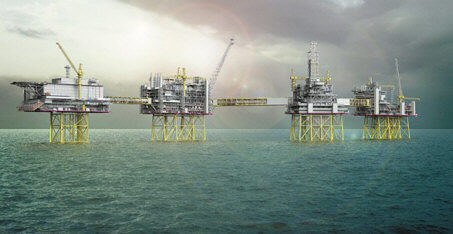|
Partners submit Johan Sverdrup development plan
Statoil lets EPC
contract for Johan Sverdrup platform deck
Feb. 13, 2015 +
+ + Partners Statoil ASA, Lundin Petroleum AB, Petoro, Det Norske
Oljeselskap ASA, and Maersk Oil have submitted a plan for development and
operation (PDO) for Phase 1 of Johan Sverdrup field to the Norwegian
Ministry of Petroleum and Energy.
The oil field—which lies on the Utsira High in
the North Sea, 155 km west of Stavanger—will be developed in several
phases. Phase 1 consists of four bridge-linked platforms and three subsea
water injection templates, with a production capacity of 315,000-380,000
boe/d (OGJ Online, Feb. 13, 2014).
Production from Phase
1 is expected to launch in late 2019. The partners are targeting a
recovery rate of 70% (OGJ Online, May 7, 2014). Expected recoverable
resources are projected between 1.4–2.4 billion boe.
In addition to the PDO, the partners will also
submit two plans for installation and operation (PIO) for pipeline
transportation and development of power from shore. Oil from the field
will be piped to the Mongstad terminal in Hordaland.
Capital expenditure for Phase 1 is estimated at
117 billion kroner, which includes offshore facilities, oil and gas export
pipelines, development wells, and power supply from shore.
Twenty-two appraisal wells drilled on Johan
Sverdrup have shown that the reservoir is of “exceptional quality” and
multiple production tests also indicate well productivity will be “very
high,” partner Lundin says (OGJ Online, Mar. 28, 2014).
As a result, Lundin expects “very short”
periods from ramp-up to plateau production for Phase 1 and subsequent
phases. Phase 2 is expected to start production in 2022.
Capex for full field-development is estimated
at 170-220 billion kroner as of 2015, with recoverable resources between
1.7-3 billion boe—95% of which is oil—and an expected plateau production
of 550,000-650,000 b/d.
The partnership
previously recommended Statoil as the operator for all phases of the field
development and operation (OGJ Online, Dec. 1, 2014).
The majority of the partnership has asked the
Ministry of Petroleum and Energy to determine the final allocation of
resources in Johan Sverdrup, proposing Statoil 40.0267%, Lundin Petroleum
subsidiary Lundin Norway AS 22.12%, Petoro 17.84%, Det norske oljeselskap
11.8933%, and Maersk Oil 8.12%.
“We are delivering the PDO for the largest oil
discovery on the Norwegian continental shelf since the 1980s,” said Eldar
Saetre, operator Statoil’s chief executive officer. “Johan Sverdrup will
generate value of great importance to Norway through several decades. The
field’s economy is robust also at current oil prices.” The field’s
breakeven price is $40/bbl.
According to analysis from Wood Mackenzie, the
field will provide more than 10% of Statoil’s global oil production by
2020. It will also boost returns and cash margin metrics, both key
industry benchmarks. WoodMac also says the field is a “company maker” for
Lundin and Det Norske. "Lundin in particular deserves credit for
discovering the field in 2010,” it says. “It will quadruple Lundin's
production and make up 98% of its upstream value by 2020. But project
sanction means intense investment for one of the most highly leveraged
companies in the sector. It’s also a vital strategic asset for Maersk Oil,
as it will mitigate the company’s long-term production decline. It will
add 48,700 boe/d of net peak production by 2024 to Maersk, equivalent to
18% of total volumes.”
Overall, the field will provide 25% of
Norwegian production by 2025, out-producing the entire UK sector.
Statoil lets EPC contract for Johan Sverdrup platform deck
Feb. 24, 2015 + + + Statoil ASA has let an
8-billion-kroner contract to Aibel AS for engineering work, procurement,
and construction of the deck for the Johan Sverdrup drilling platform.
The deck will comprise three modules. Aibel
will build the largest module, the main support frame, at the company’s
yard in Thailand. The drilling support module, the second largest, will be
built at the company’s yard in Haugesund. The final module, the drilling
equipment set, will be built by partner Nymo in Grimstad.
Work on combining the three modules will start
in fall 2017 at Haugesund. The finished platform will be handed over to
Statoil in second-quarter 2018.
“The drilling platform is one of four
platforms in the planned field center, and it is a complex and challenging
project in itself,” commented Margareth Ovrum, Statoil executive
vice-president for technology, projects, and drilling.
The contract
is subject to approval of the plan for development and operation (PDO).
The partnership submitted its PDO for Phase 1 this month (OGJ Online, Feb.
13, 2015).
In addition to Statoil, the Johan Sverdrup
partnership consists of Lundin Petroleum AB, Petoro, Det Norske
Oljeselskap ASA, and Maersk Oil. The partnership has recommended Statoil
as operator for all phases.
Source: Statoil,
www.statoil.com
Article by Oil & Gas
Journal editors
|

Worldwide more than
90,000 paid subscriptions

Worldwide
more than 48,000 subscriptions -
100% one-year direct request
qualification

'What's New' in Upstream, Midstream and
Downstream Products & Services. Circulation 37,000
PennWell
Petroleum Group:
Oil & Gas Journal
Oil & Gas Journal Russia
OGJ_eNewsletter
OGJ-Website-Statistics
Oil, Gas & Petrochem Equipment
Offshore Magazine
Offshore
Russia
Offshore eNewsletter
Offshore
Website Statistics
Oil & Gas Financial Journal
+ + +
For more information, media
kits or
sample copies please contact
Andreas
Sicking
+49 (0)2903-338570
wilhelms@pennwell.com
www.sicking.de
|


